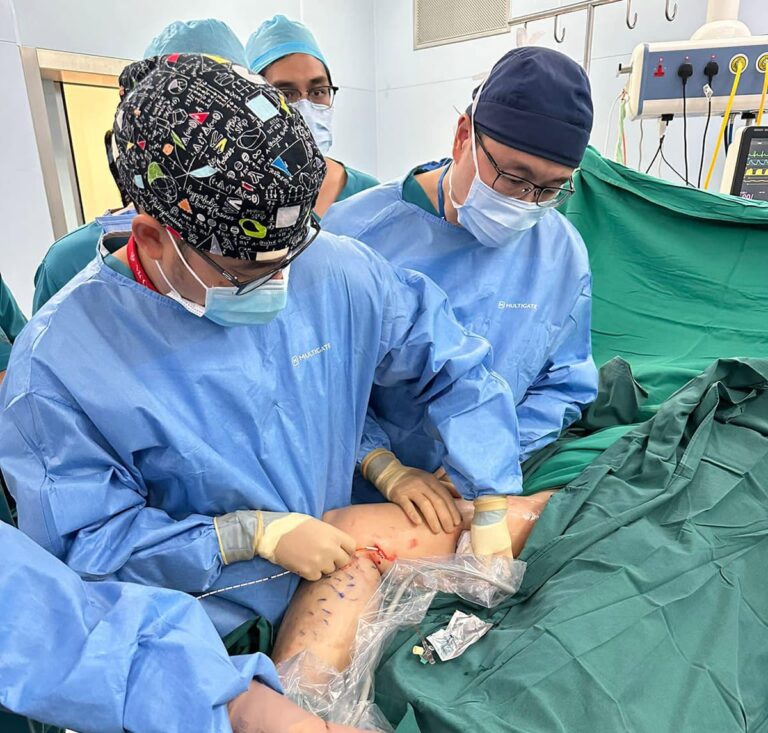Deep vein thrombosis (DVT) is typically treated with non-surgical approaches as the first line of treatment. These may include medications such as anticoagulants (blood thinners) to prevent the clot from growing and to reduce the risk of complications such as pulmonary embolism (clot on the lung).
Surgical intervention for DVT is generally reserved for severe cases or when non-surgical treatments are ineffective. Some situations where surgical treatment may be considered include:
- Thrombectomy: In certain cases, a surgical procedure called thrombectomy may be performed to remove the clot directly. This is usually done when the clot is large or causing severe symptoms, and other treatment options have not been successful.
- Vena cava filter placement: If the patient is at high risk of pulmonary embolism (a potentially life-threatening condition where a clot travels to the lungs), a vena cava filter may be surgically implanted. This filter helps prevent clots from reaching the lungs by trapping them in the vena cava, a large vein that returns blood to the heart.
The choice of surgical thrombectomy procedure for treating deep vein thrombosis (DVT) is determined by several factors:
- Location and extent of the clot: The location and size of the clot play a significant role in determining the appropriate surgical thrombectomy procedure. Different procedures may be more effective for clots in specific veins or at particular locations within the veins. For example, catheter-directed thrombolysis is commonly used for iliac vein clots, while mechanical thrombectomy may be preferred for more extensive clots.
- Severity of symptoms: The severity of the patient’s symptoms and the potential for complications are important considerations. If the clot is causing severe symptoms such as pain and swelling or if there is a high risk of complications such as skin breakdown, a more aggressive surgical thrombectomy procedure may be chosen.
- Age of the clot: Generally if the clot is fresh it is easier to suck out using percutaneous thrombectomy methods. Older clots generally >2 weeks old become more difficult to remove because they are congealed in nature and may need the addition of thrombolysis or clot busters to help break down the clot first.
- Patient’s overall health: The patient’s health and medical history are crucial in determining the suitability of different surgical thrombectomy procedures. Factors such as age, presence of other medical conditions, and previous surgeries or interventions may impact the choice of procedure.
Surgical Options to Remove Clots in the Legs and Arms
Several types of surgical thrombectomy procedures may be performed to treat deep vein thrombosis (DVT). The choice of procedure depends on various factors, including the location, age and extent of the clot and the patient’s overall health. Here are some common types of surgical thrombectomy:
- Catheter-directed thrombolysis: This procedure involves the insertion of a catheter into the affected vein. Through the catheter, a clot-dissolving medication is delivered directly to the clot, helping to break it down. This approach is often used for DVT in the larger veins of the leg, such as the iliac veins.
- Mechanical thrombectomy: Mechanical thrombectomy involves the use of specialized devices to physically remove or break up the clot. These devices may include rotating wires, suction catheters, or thrombectomy devices that mechanically extract the clot. This technique is often used when the clot is large or difficult to dissolve with medication alone.
- Open surgical thrombectomy: In certain cases, open surgical thrombectomy may be performed. This involves making an incision in the affected area and directly removing the clot. Open surgical thrombectomy is typically reserved for more severe cases or when other less invasive techniques are not suitable.
How can percutaneous thrombectomy improve the quality of life for patients?
Percutaneous thrombectomy can improve the quality of life for patients in several ways:
- Relief from symptoms: Deep vein thrombosis (DVT) can cause symptoms such as pain, swelling, and difficulty in moving the affected limb. By removing the blood clot causing the obstruction, percutaneous thrombectomy can alleviate these symptoms and improve the patient’s comfort and mobility. This can lead to a significant improvement in their quality of life.
- Restoration of blood flow: DVT can restrict blood flow in the affected blood vessels, leading to various complications. By removing the clot and restoring blood flow, percutaneous thrombectomy can help prevent further complications such as pulmonary embolism or post-thrombotic syndrome. Improved blood flow can promote healing, reduce the risk of long-term complications, and enhance the patient’s overall well-being.
- Faster recovery and return to normal activities: Compared to open surgical procedures, percutaneous thrombectomy is minimally invasive and typically requires a shorter hospital stay. This can result in a faster recovery time and a quicker return to normal activities for patients. Being able to resume daily activities and routines can greatly improve the quality of life by reducing dependence on others and allowing individuals to regain their independence.
- Prevention of long-term complications: DVT can lead to long-term complications such as chronic pain, swelling, and skin changes in the affected limb, known as post-thrombotic syndrome. By effectively treating the underlying cause of DVT through percutaneous thrombectomy, the risk of these complications can be significantly reduced or even prevented, improving the patient’s long-term quality of life.
- Psychological well-being: Living with DVT can cause anxiety, stress, and a reduced quality of life due to the physical limitations and potential complications associated with the condition. By successfully treating the clot and improving blood flow, percutaneous thrombectomy can help alleviate these psychological burdens and improve the patient’s overall well-being.
What are the latest percutaneous thrombectomy devices?
There are several percutaneous thrombectomy devices available, and new devices are constantly being developed and improved. Here are some of the latest percutaneous thrombectomy devices:
- AngioJet™️ System: The AngioJet™️ System is a mechanical thrombectomy device that uses high-pressure saline jets to break up and remove blood clots. It combines a thrombectomy catheter with a console that generates high-pressure saline jets. The system has been used for percutaneous thrombectomy in various vascular beds, including peripheral arteries and veins.
- Indigo®️ System: The Indigo®️ System is a vacuum-assisted thrombectomy device that utilizes aspiration to remove blood clots. It consists of a catheter with an expandable tip that creates a vacuum to extract the clot. The system offers different catheter sizes and configurations to accommodate various clot sizes and locations.
- Penumbra®️ System: The Penumbra®️ System is another aspiration-based thrombectomy device that uses a catheter to remove blood clots. It includes a separator that isolates the clot, allowing for effective aspiration. The Penumbra®️ System has been used for percutaneous thrombectomy in both arterial and venous occlusions.
- FlowTriever®️ System: The FlowTriever®️ System is a mechanical thrombectomy device that uses a large-bore catheter to capture and remove blood clots. It utilises a unique self-expanding nitinol mesh to trap the clot while maintaining blood flow. The system has been primarily used for the treatment of pulmonary embolism, a type of blood clot that affects the lung arteries.
It’s important to note that the choice of a thrombectomy device depends on various factors, including the location and extent of the clot, the patient’s overall health, and the preference of the treating physician. The selection of the most appropriate device is made on a case-by-case basis by your vascular specialist. At the VEC, our vascular surgeons have one of the largest experiences in Singapore using the latest percutaneous thrombectomy devices such as the Penumbra Flash lightning and Inari’s Flow Triever devices.









